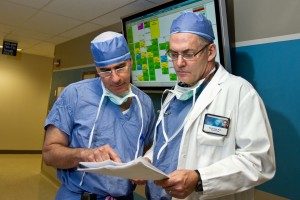-
 Cardiovascular
CardiovascularNew Mayo Clinic Cardiovascular Surgical Care Model Improves Care Value, Predictability and the Patient Experience
ROCHESTER, Minn. — New research from Mayo Clinic shows that implementing a uniform method to care for lower-risk cardiac surgical patients improves outcomes, reduces patients’ time in the hospital and lowers overall per patient costs by 15 percent. The study is published in the May issue of Health Affairs.
Journalists: Sound bites with Dr. Cook are available in the downloads.
“In the high-acuity, full-service hospital, individual clinical judgment remains key, and some medical care demands this,” says David Cook, M.D., a Mayo Clinic anesthesiologist and primary author of the study. “But if this philosophy is applied universally, the same medical problem could be approached in 10 different ways by 10 different physicians, leading to unwarranted variability in costs, quality and outcomes.”
In 2009, practice leaders at Mayo Clinic initiated a practice redesign effort targeted at lower-risk cardiovascular surgical patients that would set clear expectations for their hospital care, improve patients’ experiences and outcomes, and reduce overall costs. The group used stakeholder analysis, practice analysis and management tools such as Lean and Six Sigma to design the new model of care. Key elements of the model included:
- Stratification of the patient population into lower and higher complexity to identify which patients could be cared for using the standardized model
- New workflow paths that empowered nonphysician care providers to make decisions at the bedside
- Co-location of patients with similar levels of acuity
- Health IT tools to support work models and care delegation
“Our effort to disrupt the typical model of a full-service hospital surgery practice provides evidence of the power of a standardized care model to improve care value,” Dr. Cook explains. “I nstead of treating all patients as highly complex and requiring unique problem-solving, we found that 67 percent of our patients would be amenable to a new care model that achieved a high degree of predictability.”
nstead of treating all patients as highly complex and requiring unique problem-solving, we found that 67 percent of our patients would be amenable to a new care model that achieved a high degree of predictability.”
“For patients and families, uncertainty is a significant burden,” he continues. “Now, we’ve made care predictable enough so that we can tell patients and families what they can expect, and this is tremendously important.”
Dr. Cook says that it’s critical to apply the right tools, care model and work model to the right patient population. Part of the reason that protocols or best practices fail, he says, is that providers may not follow them if they are not applied, with forethought, to the right patient population. He also stresses that persistent leadership and phased implementation of changes are critical for such initiatives to succeed.
Co-authors include Jeffrey E. Thompson; Elizabeth Habermann, Ph.D.; Sue Visscher, Ph.D.; Joseph Dearani, M.D.; Véronique Roger, M.D.; and Bijan Borah, Ph.D. The Mayo Clinic Robert D. and Patricia E. Kern Center for the Science of Health Care Delivery supported this study by assessing outcomes and costs before and after the implementation of the new care model.
###
About Mayo Clinic
Recognizing 150 years of serving humanity in 2014, Mayo Clinic is a nonprofit worldwide leader in medical care, research and education for people from all walks of life. For more information, visit 150years.mayoclinic.org, mayoclinic.org and newsnetwork.mayoclinic.org.
MEDIA CONTACT: Shelly Plutowski, Mayo Clinic Public Affairs, 507-284-5005, newsbureau@mayo.edu







